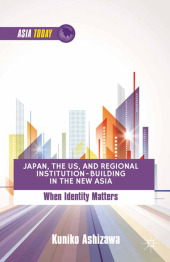 Neuerscheinungen 2013Stand: 2020-01-07 |
Schnellsuche
ISBN/Stichwort/Autor
|
Herderstraße 10
10625 Berlin
Tel.: 030 315 714 16
Fax 030 315 714 14
info@buchspektrum.de |

K. Ashizawa
Japan, the US, and Regional Institution-Building in the New Asia
When Identity Matters
1st ed. 2013. 2013. xv, 271 S. 216 mm
Verlag/Jahr: SPRINGER PALGRAVE MACMILLAN; PALGRAVE MACMILLAN US 2013
ISBN: 1-349-45564-4 (1349455644)
Neue ISBN: 978-1-349-45564-5 (9781349455645)
Preis und Lieferzeit: Bitte klicken
Providing a thorough and novel account of US and Japanese foreign policymaking toward regional institution-building in post-Cold War Asia, this study serves as the first comparative analysis of these two major actors in this realm of regional cooperation and demonstrates not only how but also when state identity shapes a state´s foreign policy.
PART I: INTRODUCTION 1. The Argument 2. Where Does This Stand? PART II: THE VALUE-ACTION FRAMEWORK AND STATE IDENTITY 3. The Value-Action Model of Foreign Policy Analysis 4. The Structural Dimension 5. The Dispositional Dimension 6. The Intentional Dimension 7. State Identity and Foreign Policy 8. State Identity: Definition 9. Identity-Value Nexus 10. Why Identity? When Does It Matter? PART III: JAPAN AND THE CREATION OF APEC: MITI´S QUIET MANEUVER, 1988-1989 11. Explaining Japan´s Policymaking toward the Creation of APEC 12. Historical Narrative: Part I 13. The Value-Action Analysis: The Structural Dimension 14. Historical Narrative: Part II 15. The Value-Action Analysis: The Dispositional Dimension 16. State Identity: The Source of The Determinant Values 17. Decision-Making Context: Conceptualizaing a New Regional Order 18. A Dual Member of Asia and the West 19. Identity-Value Nexus 20. Remaining Questions and Competing Explanations PART IV: THE UNITED STATES AND THE CREATION OF APEC: GLOBAL HEGEMON AND REGIONAL COOPERATION, 1988-1989 21. Explaining U.S. Policymaking toward the Creation of APEC 22. Historical Narrative Part I: The United States and MITI´s Proposal 23. The Value-Action Analysis: The Structural Dimension 24. Historical Narrative Part II: The Hawke Speech and Comprehensive Policy Review 25. The Value-Action Analysis: Activation of Decision-Making 26. Historical Narrative Part III: ´An Idea Whose Time Has Come´ 27. The Value-Action Analysis: The Dispositional Dimension 28. Two Concepts of U.S. State Identity: The Sources of The Determinant Values 29. A Pacific Power 30. An International Institution-Builder 31. On Competing Explanations PART V: JAPAN AND THE CREATION OF THE ARF: MOFA IN MOTION, 1991-1994 32. Explaining Japan´s Policymaking toward the Creation of the ARF 33. Historical Narrative Part I: The Nakayama Proposal 34. The Value-Action Analysis: The Structural Dimension 35. Historical Narrative Part II: MOFA´s Persistent Commitment 36. The Value-Action Analysis: The Dispositional Dimension 37. Two Concepts of Japanese State Identity: The Sources of the Determinant Value 38. A Past Aggressor in Asia 39. A Dual Member of Asia and the West 40. Remaining Questions and an Alternative Explanation PART VI: THE UNITED STATES AND THE CREATION OF THE ARF: HEGEMONIC APPROACH TOWARD THE POST-COLD WAR ASIAN SECURITY ORDER, 1990-1994 41. Explaining U.S. Policymaking toward the Creation of the ARF 42. Historical Narrative Part I: Appraising Past Success 43. The Value-Action Analysis: The Structural Dimension 44. Historical Narrative Part II and Decision-Making Activation: Lord´s ´Ten Major Goals´ 45. Historical Narrative Part III: Toward the First ARF Meeting 46. The Dispositional Dimension: Stay Engaged with Asia 47. The Pacific Power Identity: The Source of the Engagement Value 48. An Alternative Explanation, A Remaining Question PART VII: CONCLUSION 49. State Identity and Foreign Policy 50. Japan, the United States, and Institution-Building in 21st Century Asia


